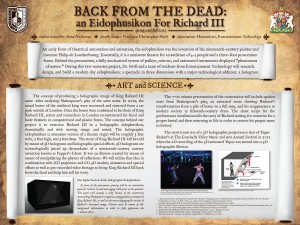 In the Spring of 2013 and Fall of 2104, I mentored six Entertainment Technology majors in the construction of an eidophusikon with “Pepper’s Ghost” (holographic simulation) technology. The miniature theatre machine we built was based on a historical nineteenth-century object using twentieth-century technologies. An early form of movie-making, the eidophusikon was the invention of the nineteenth-century painter and inventor Philip de Loutherbourg. Essentially, it is a miniature theatre for a small audience. Behind the 4-foot proscenium, a fully mechanized system of pulleys, mirrors, and automated instruments displayed “phenomena of nature.”
In the Spring of 2013 and Fall of 2104, I mentored six Entertainment Technology majors in the construction of an eidophusikon with “Pepper’s Ghost” (holographic simulation) technology. The miniature theatre machine we built was based on a historical nineteenth-century object using twentieth-century technologies. An early form of movie-making, the eidophusikon was the invention of the nineteenth-century painter and inventor Philip de Loutherbourg. Essentially, it is a miniature theatre for a small audience. Behind the 4-foot proscenium, a fully mechanized system of pulleys, mirrors, and automated instruments displayed “phenomena of nature.”
The concept of producing a 3-D movie of King Richard III in the context of a theatrical display came from a paper written by Irina Nechaeva about Shakespeare’s play. The actual bones of Richard III had recently been recovered from a car park outside of London. Once the bones were confirmed to be those of the medieval King Richard III, artists and researchers in London reconstructed his facial and body features in computer and plastic forms. We had the idea of producing a similar recreation of dramatic and historical iterations of Richard as a “Pepper’s Ghost” — a visual trick that makes images look holographic. We first researched the historical subject, created initial holographic films, and devise a short script for performance. During the second semester, the eidophusikon was constructed with computerized mise-en-scene and put on display for public viewing.
Project Description: Eidophusikon Brochure
Emerging Scholars Application: An Eidophusikon for Richard III
Emerging Scholars Application: Eidophusikon, Part 2
OpenLab Project Site


